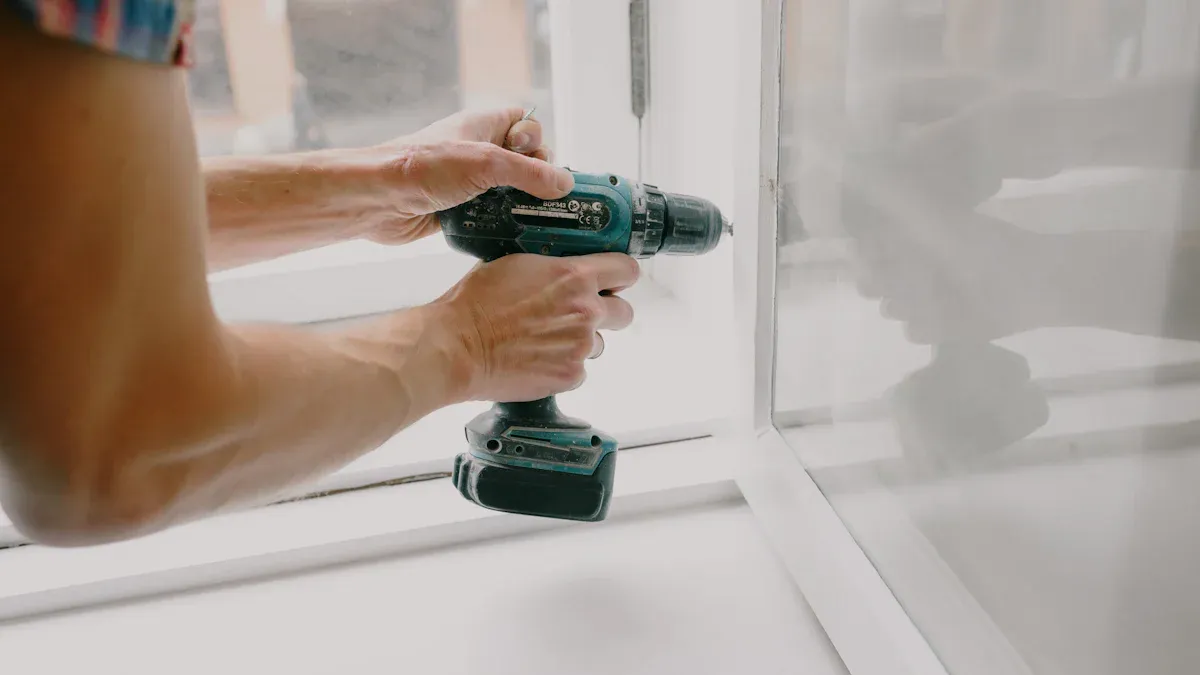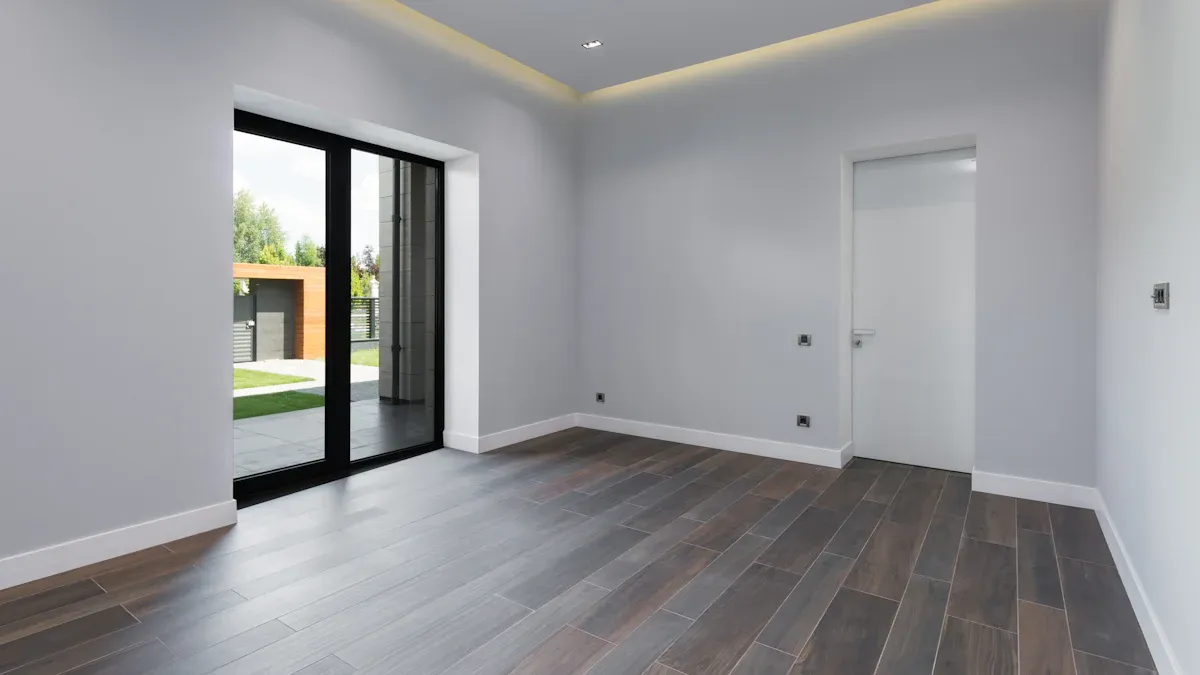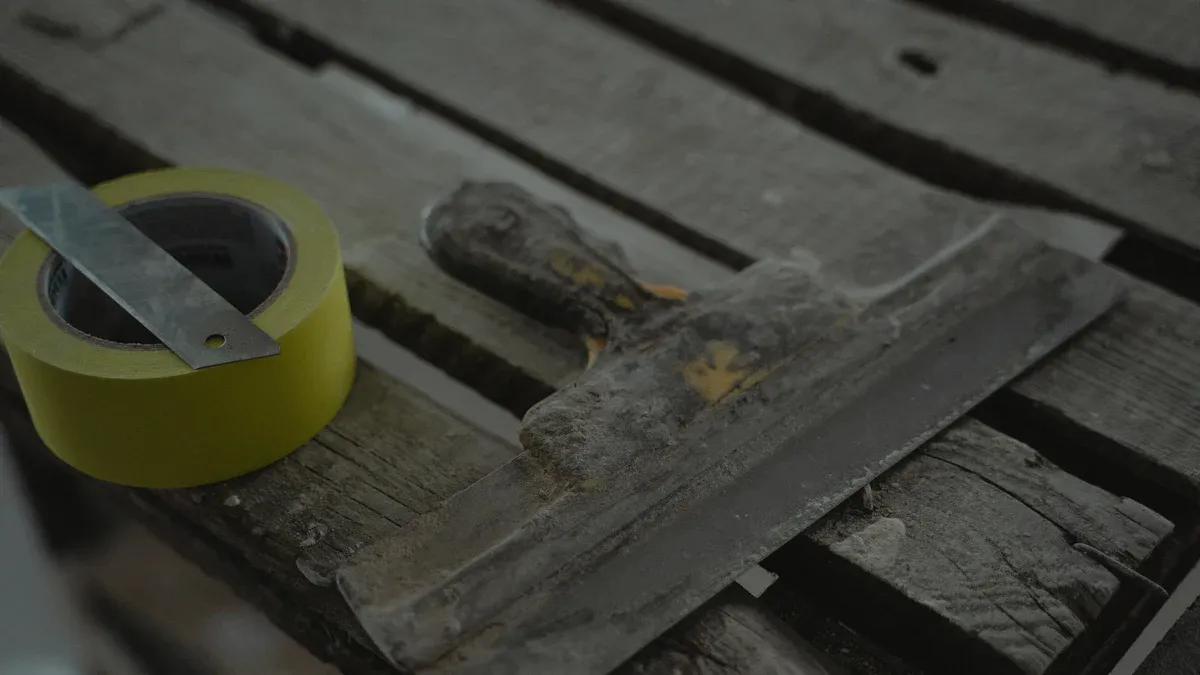Construction And Decoration Silicone Sealant: The Secret Glue of Modern Homes

You may not notice it, but Construction And Decoration Silicone Sealant plays a big role in your home. This material bonds, seals, and protects important areas, making your living spaces safer and more comfortable. People call it the "secret glue" because it keeps things strong and lasting without being seen.
- The global market for silicone sealants reached $3.81 billion in 2021.
- Experts expect it to grow to $6.43 billion by 2031, driven by more housing and the need for high-performance products.
When you use this sealant, you help your home stand up to daily wear and weather.
Key Takeaways
- Silicone sealant creates strong, flexible, and long-lasting seals that protect your home from water, air, and weather damage.
- It works well on many surfaces like glass, metal, wood, and ceramics, making it ideal for sealing joints, windows, doors, bathrooms, and kitchens.
- Using the right type of silicone sealant and preparing surfaces properly ensures the best results and prevents leaks or cracks.
- Silicone sealants resist mold, UV rays, and temperature changes, helping your home stay clean, energy-efficient, and comfortable.
- Regular inspection and gentle cleaning keep silicone seals in good condition, extending their life up to 20 years and saving you money on repairs.
Why Construction And Decoration Silicone Sealant Is Essential
Key Properties and Performance
You rely on Construction And Decoration Silicone Sealant because it brings a unique set of properties that make your home safer and more comfortable. This sealant stands out for its ability to handle tough conditions and keep working for years. Here are some of the most important features:
- Superior UV and thermal resistance, so you can use it outdoors without worrying about sunlight or temperature changes.
- High movement capability, which means it stretches and compresses as your house shifts or settles.
- Excellent adhesion to many surfaces, including glass, metal, wood, and ceramics.
- Long service life and flexibility, so it keeps gaps sealed even as materials expand and contract.
- Chemically stable and non-reactive, which helps it resist breakdown from weather, water, and chemicals.
- Strong water repellency, making it perfect for bathrooms, kitchens, and other wet areas.
- Airtight and watertight seals that prevent drafts and leaks, improving your home's energy efficiency.
- Safe for use near electrical components and available in types designed for high temperatures or extra flexibility.
Tip: Always prepare surfaces properly and choose the right type of sealant for your project. This ensures the best performance and longest-lasting results.
You can see how the mechanical and thermal properties of silicone sealant help it perform in your home:
| Property | Value/Description |
|---|---|
| Movement Capability | ±50% (handles building movement) |
| Elongation | 525% (very flexible) |
| Tensile Strength | 350 psi (strong bond) |
| Tear Strength | 49 ppi (resists damage) |
| Shore A Hardness | 40 (good balance of firmness and flexibility) |
| Thermal Resistance | High (works in hot and cold) |
| UV Resistance | Excellent (lasts in sunlight) |
| Water Resistance | Yes (keeps water out) |
| Weatherability | Excellent (handles outdoor use) |
| Sag/Slump Resistance | Low (good for vertical surfaces) |
| Adhesion | Excellent to glass, metals, and more |

These features make silicone sealant a top choice for sealing, protecting, and improving your home.
Advantages Over Other Adhesives
When you compare silicone sealant to other adhesives like polyurethane or acrylic, you notice some clear advantages. Silicone sealants last longer and handle tough environments better. Here is a quick comparison:
| Feature | Silicone Sealant | Polyurethane Sealant | Acrylic Sealant |
|---|---|---|---|
| Heat Resistance | Exceptional; stable in high temperatures | Good, but less than silicone | Poor; not suitable for high heat |
| UV Resistance | Excellent; resists UV erosion | Limited; may need protection | Poor; damaged by sunlight |
| Waterproofing | Excellent; strong moisture barrier | Good; resists weather and chemicals | Limited; not for wet or outdoor areas |
| Flexibility | Stays elastic after curing | Excellent; handles stress | Moderate; may shrink |
| Adhesion | Good on many surfaces | Superior on many substrates | Good but less durable |
| Paintability | Not paintable | Not paintable | Paintable |
| Application Areas | Indoor/outdoor; wet and hot spots | Indoor/outdoor; high-stress joints | Indoor; dry areas |
| Durability | Long-lasting; resists weather and temperature | Durable and strong | Less durable |
You get several benefits when you choose silicone sealant:
- Weatherproof and UV-resistant, so it stands up to rain, sunlight, and temperature swings.
- Strong adhesion to many materials, including concrete, metal, wood, glass, PVC, and ceramics.
- Flexible and crack-resistant, keeping its seal even as your home moves.
- Eco-friendly with low VOCs, making it safe for indoor and outdoor use.
Silicone sealants may cost more at first, but you save money over time. They help your home use less energy by sealing out drafts and moisture. Their long life means you spend less on repairs and replacements. You also help the environment because many silicone sealants have low emissions and can be recycled.
Note: While silicone sealants are not paintable, their durability and resistance to weather make them the best choice for many home projects.
Common Uses of Construction And Decoration Silicone Sealant in Homes

Sealing Construction Joints and Gaps
You often see Construction And Decoration Silicone Sealant used to seal joints and gaps in your home. These joints appear where two building materials meet, such as between walls and floors or around window frames. If you leave these gaps open, air, water, and even insects can get inside. Silicone sealant fills these spaces, keeping your home safe and comfortable.
Here are some of the most common places where you might use silicone sealant:
- Joints between glass and plastic panels
- Corners and flat joints inside rooms
- Gaps in masonry, such as brick or stone walls
- Exterior seams, like gutters and roof flashing
You can find silicone sealants in most hardware stores because they are so popular for home improvement projects. They work well for both cosmetic and functional purposes. You can make small gaps disappear and stop air or water from leaking through joints.
To get the best results, you should follow these best practices:
- Clean and dry the surfaces before applying the sealant.
- Use a backer rod for deeper joints to control the depth of the sealant.
- Apply the sealant evenly with a caulking gun.
- Tool the sealant with a spatula, not your finger, for a smooth finish.
- Mask off areas you do not want to smear.
- Allow the sealant to cure as the manufacturer recommends.
- Inspect the joint after curing and reapply if you see gaps.
- Check sealed joints regularly and repair any damage.
When you use silicone sealant correctly, you prevent common failures such as cracking, loss of flexibility, and adhesion problems. You also protect your home from moisture, temperature changes, and movement caused by settling or weather.
🛠️ Tip: Always design joints to handle movement. This helps the sealant last longer and keeps your home protected.
Bathrooms and Kitchens
Bathrooms and kitchens need special care because they stay wet and humid. You want to keep these areas clean and free from mold. Silicone sealant is the best choice for sealing around sinks, bathtubs, showers, and countertops.
You get several benefits when you use silicone sealant in these rooms:
- Complete waterproofing after curing
- High flexibility, so it does not crack or shrink
- Strong adhesion to ceramic, tile, glass, and metal
- Resistance to mold and mildew
- Long-lasting protection, even with frequent cleaning and temperature changes
Silicone sealants contain antifungal and antibacterial additives. These additives stop mold from growing in wet areas. The sealant forms a watertight barrier, so water cannot seep behind tiles or fixtures. This keeps your bathroom and kitchen looking clean and smelling fresh.
You should choose a neutral-cure silicone for delicate surfaces. Some types can damage certain materials, so always check the label. Silicone sealants may be harder to paint or clean up, but their performance in wet areas makes them the top choice.
🚿 Note: Silicone sealant can keep your bathroom and kitchen mold-free for up to 20 years if you apply it properly and keep it clean.
Windows, Doors, and Façades
You want your windows and doors to keep out drafts, rain, and noise. Silicone sealant helps you achieve this by creating airtight and watertight seals. When you apply it around window frames, door frames, and building façades, you improve your home's insulation and weatherproofing.
Silicone sealants offer these advantages:
- Flexible and durable joints that resist UV rays, ozone, and temperature changes
- Airtight seals that stop air and water from leaking in or out
- Strong adhesion to glass, metal, PVC, and concrete
- Long-lasting performance, even in harsh weather
When you seal windows and doors with silicone, you help your home save energy. The sealant keeps warm air inside during winter and cool air inside during summer. This reduces the work your heating and cooling systems need to do, which lowers your energy bills.
Here is a quick look at how silicone sealant improves window and door performance:
| Feature | Benefit for Your Home |
|---|---|
| Airtight Seal | Stops drafts and saves energy |
| Watertight Barrier | Prevents leaks and water damage |
| UV and Weatherproof | Lasts longer in sunlight and rain |
| Flexible Bond | Handles movement and temperature changes |
| Strong Adhesion | Works on many building materials |
💡 Tip: Always use high-quality silicone sealant for windows and doors. Poor-quality products can fail, causing leaks and higher energy costs.
Decorative and Specialty Applications
You can use silicone sealant for much more than just sealing gaps and joints. In modern homes, creative people have found many ways to use this material for decoration and specialty projects. These uses help you add style, personality, and even function to your living spaces.
- Silicone planters let you grow plants indoors with containers that resist water and last a long time. You can shape them into almost any design, so your plants look unique on shelves or tables.
- Candle holders made from silicone molds give you a safe and stylish way to add soft light to your rooms. You can pick colors and shapes that match your mood or the season.
- Custom silicone bowls combine art and function. You can use them in your kitchen or as decorative pieces in your dining area.
- Mosaic crafts become easier and more durable when you use silicone sealant. You can glue broken tiles onto walls, floors, or garden paths. The sealant keeps the pieces in place and protects them from water.
- Decorated mirror frames stand out when you attach seashells, mosaic tiles, or other found objects. Silicone sealant holds these items securely and lets you create a frame that matches your style.
- Aquariums and terrariums stay leak-free and flexible when you build them with silicone sealant. You can design your own fish tanks or plant displays that fit your space perfectly.
- Furniture upgrades become possible when you add glass, metal, or ceramic tiles to tables or cabinets. Neutral-colored silicone blends in, so the focus stays on your design.
- Outdoor art and sculptures last longer when you use silicone sealant to join reclaimed materials. Your creations can stand up to rain, sun, and wind.
- Stained glass projects become safer and more affordable. Silicone sealant lets you join glass pieces without special tools, so you can make colorful showpieces for your home.
💡 Tip: Try using silicone sealant for your next DIY project. You can create something beautiful and long-lasting, even if you have never worked with this material before.
Silicone sealant does more than just hold things together. It helps your decorative projects last longer and look better. For example, some high-performance sealants, like DOWSIL™ 991, protect natural stone from stains and keep metal and glass surfaces free from streaks. These sealants move with your home, so your decorations do not crack or peel. They also resist UV rays and weather, which means your outdoor art stays bright and strong.
You can also find sealants, such as StoSeal STPE, that stick well to many surfaces without a primer. These products keep dirt away, so your decorations stay clean. Many sealants come in different colors, so you can match or highlight your design. This makes it easy to blend the sealant with your project or make it stand out.
| Decorative Use | Benefit | Where to Use It |
|---|---|---|
| Planters | Flexible, waterproof, unique designs | Living room, kitchen |
| Candle Holders | Custom shapes, heat resistant | Bedroom, dining area |
| Mosaic Art | Strong bond, water resistant | Walls, garden paths |
| Mirror Frames | Personal touch, secure hold | Bathroom, hallway |
| Aquariums/Terrariums | Leak-proof, flexible | Living room, office |
| Furniture Decoration | Seamless finish, durable | Tables, cabinets |
| Outdoor Sculptures | Weatherproof, long-lasting | Garden, patio |
| Stained Glass | Safe assembly, creative freedom | Windows, doors |
You can see that silicone sealant opens up many possibilities for decorating your home. It helps you create projects that last, look great, and reflect your personal style.
How Construction And Decoration Silicone Sealant Works
Chemical Composition and Curing
You might wonder how Construction And Decoration Silicone Sealant changes from a soft paste to a tough, flexible seal. The secret lies in its chemical makeup. Silicone sealants use silicone polymers that react with moisture in the air. When you apply the sealant, it starts to cure by absorbing water vapor. This reaction forms a strong, rubbery material that can stretch and bend.
The curing process depends on several factors:
- Temperature: Warm air speeds up curing, but too much heat can weaken the bond.
- Humidity: High humidity helps the sealant cure faster, while dry air slows it down.
- Surface type: Porous surfaces like brick absorb moisture and speed up curing. Non-porous surfaces like glass slow it down.
- Thickness: Thick layers cure on the outside first and may stay soft inside.
You can choose between one-part and two-part sealants. One-part types are easy to use and cure with air moisture. Two-part types need mixing and cure faster, making them good for factory jobs.
Tip: Always remove old sealant before applying new. Silicone does not stick well to itself.
Bonding, Sealing, and Flexibility
You rely on silicone sealant because it bonds to many surfaces, such as glass, metal, concrete, and tile. The sealant forms a tight grip without needing a primer in most cases. This strong bond keeps out water, air, and dust.
Silicone sealant stays flexible even after it cures. It stretches and compresses as your house moves or as temperatures change. This flexibility prevents cracks and keeps the seal tight for years. Some products can handle movement up to 100% of the joint width.
| Property | Value/Description |
|---|---|
| Flexibility | Excellent for moving joints |
| Tensile Strength | Up to 175 psi |
| Service Temperature | -80°F to +350°F |
| Adhesion | Bonds well to many materials |
You get a seal that lasts through hot summers, cold winters, and daily use.
Durability and Resistance
You want a sealant that stands up to time and weather. Construction And Decoration Silicone Sealant can last up to 20 years in your home if you apply it well and keep it clean. It resists UV rays, rain, snow, and big temperature swings. Special UV stabilizers in the sealant protect it from sunlight, so it does not crack or fade.
Regular checks help you spot problems early. Look for signs like peeling, gaps, or mold. Clean the sealant gently and replace it if it loses its stretch or color. High-quality sealants with UV blockers and mold fighters last longer, especially outdoors.
Note: Outdoor silicone sealants can handle extreme heat and cold, making them perfect for windows, roofs, and siding.
Choosing the Right Construction And Decoration Silicone Sealant
Types for Different Applications
You need to pick the right type of silicone sealant for each job in your home. Different areas require different features. The table below shows which sealant works best for common home projects:
| Sealant Type | Characteristics | Best Home Applications |
|---|---|---|
| High modulus acetoxy | Fast curing, rigid, mildew-resistant | Kitchens, bathrooms (baths, showers, tile, glass) |
| Low modulus neutral | Flexible, weatherproof, vinyl-friendly | Outdoor use (windows, doors, exterior surfaces) |
| Low modulus acetoxy | All-purpose, less durable | General sealing, sanitary, exterior glazing |
For kitchens and bathrooms, you should use anti-mold silicone sealants. Neutral types work well on metal and marble because they do not cause corrosion. For outdoor areas like windows and doors, low modulus neutral sealants provide flexibility and weather resistance. Fire-rated areas need special fireproof silicone sealants.
Reading Labels and Product Features
You should always read the label before buying a sealant. Look for these important features:
- Mold resistance: Needed for wet areas like bathrooms and kitchens.
- Neutral cure: Safe for metals and natural stone.
- UV and weather resistance: Important for outdoor use.
- Fire resistance: Required for fire-rated joints and walls.
- Adhesion: Check if it sticks to your materials (glass, tile, metal, vinyl).
Some products, like Tengyu TNS755, offer up to 10 years of mold protection and fast water resistance. Others, such as TAS685, provide 20 years of mold and mildew protection. Always match the sealant’s features to your project’s needs.
📝 Tip: Acidic sealants stick well to glass and ceramics but can damage metals. Neutral sealants are safer for most surfaces.
Mistakes to Avoid
Many people make simple mistakes when choosing or applying silicone sealant. You can avoid these problems by following these steps:
- Clean and dry the surface before applying sealant.
- Choose the right type for your project (mold-resistant for bathrooms, UV-resistant for outdoors).
- Apply a thin, even bead and smooth it right away.
- Use masking tape for neat edges and remove it after smoothing.
- Allow the sealant to cure fully before exposing it to water or weather.
- Remove old sealant and debris before applying new.
- Use primer on porous surfaces like brick or concrete.
- Check the expiration date and store sealant in a cool, dry place.
- Wear gloves and work in a well-ventilated area for safety.
- Apply sealant within the recommended temperature range.
⚠️ Note: Rushing the job or skipping steps can lead to weak seals, leaks, and costly repairs.
Applying and Maintaining Construction And Decoration Silicone Sealant

Step-by-Step Application Guide
You can achieve a strong, lasting seal by following these steps:
- Plan your joints based on where you need flexibility and protection.
- Decide what performance you need, such as waterproofing or mold resistance.
- Choose the right sealant and test it for compatibility with your surfaces.
- Clean the area. Make sure it is dry and free from dust, grease, or old sealant.
- Apply primer if the instructions recommend it. Only use primer on clean surfaces.
- Place a backer rod or masking tape if you need to control the depth or keep lines neat.
- Cut the nozzle at an angle and load the cartridge into a caulking gun.
- Fill the joint with steady pressure, making sure there are no air pockets.
- Tool the sealant right away with a spatula or tool. This helps the sealant stick well and look smooth.
- Remove masking tape before the sealant starts to cure.
- Check your work. Clean up any smears with a recommended solvent before the sealant hardens.
🛠️ Tip: Always use sealant within its shelf life and store it in a cool, dry place.
Curing and Finishing
After you apply the sealant, curing begins. The surface forms a skin in 5 to 30 minutes, depending on temperature and humidity. Full curing usually takes 24 to 48 hours. Thicker layers need more time. Warm temperatures and higher humidity help the sealant cure faster. Clean, dry surfaces also speed up the process.
Proper curing is important. It lets the sealant become flexible and weather-resistant. Avoid touching or moving the sealant until it has cured completely.
| Curing Stage | Typical Time | What to Expect |
|---|---|---|
| Skin Formation | 5–30 minutes | Surface is tack-free |
| Full Cure (1–2 mm) | 24–48 hours | Sealant is strong and flexible |
Cleaning and Maintenance
You can keep your sealant in good shape with regular care:
- Inspect sealed areas every few months for cracks, gaps, or discoloration.
- Clean the sealant with mild soap and water. Avoid harsh chemicals that can damage it.
- Repair or replace sealant if you see damage. Remove old sealant with a sharp tool or remover.
- Use UV-resistant sealants in sunny spots to prevent fading or cracking.
- Store unused sealant in a cool, dry place to keep it fresh.
🔍 Note: Quick repairs and gentle cleaning help your sealant last longer and protect your home.
You can count on Construction And Decoration Silicone Sealant to keep your home strong, comfortable, and beautiful. When you choose the right product and apply it with care, you protect your living space from water, drafts, and damage.
Remember: Learning how to select, use, and maintain your sealant gives you peace of mind and long-lasting results.
FAQ
How long does silicone sealant last in a home?
You can expect silicone sealant to last up to 20 years if you apply it correctly and keep it clean. Regular checks help you spot any damage early.
Can you paint over silicone sealant?
You cannot paint over most silicone sealants. Paint does not stick well to silicone. If you need a paintable surface, choose a different type of sealant.
What should you do if mold appears on the sealant?
Clean the area with mild soap and water. If mold returns, remove the old sealant and apply a new, mold-resistant silicone sealant.
Is silicone sealant safe for use around food areas?
Yes, many silicone sealants are food-safe once cured. Always check the product label for safety information before using it near food or in kitchens.
How do you remove old silicone sealant?
Use a sharp utility knife or a special sealant remover. Gently cut along the edges and peel away the old sealant. Clean the area before applying new sealant.
See Also
How Homeowners Can Coordinate Door Hardware And Hinge Finishes
Top 25 Construction Website Designs That Inspire Creativity
Insights Into Designer Creativity Through Computer Chip Analysis
Comparing Leading Manufacturers Of Ampoule Filling Production Lines